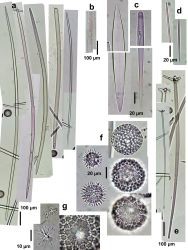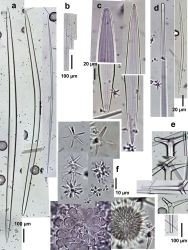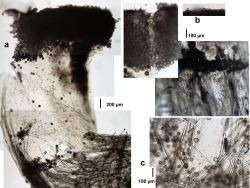brown
cinnamon-tan
massive
tube
vase
hard
tough
Bahamas
Colombia
Geodia neptuni
Description: Large and thick, inverted cones, with deep furrows in the inner surface and shallower furrows and scattered holes, rounded or elongated, in the outer surface; the wall of the cones may be relatively thin or relatively thick, in the latter with a rounded concave oscular plate. Individuals may reach 1 m in diameter and height. Oscules are located inside the furrows, more grouped towards the center and sparse in the outer portions. Smaller individuals or tend to be massive, with a central depression (or several smaller ones) with a concave oscular plate. Surface in between holes is usually smooth and rather shiny, although it can be fouled. Color cinnamon-tan to brown, with orange tinges; interior cream. Consistency very hard and tough, difficult to cut or tear. The peripheral skeleton from exterior to interior is conformed first by a cortex of densely packed sterraster microscleres, up to 875 µm in thickness, traversed horizontally and vertically by canals, the latter ones being up to 50 µm in diameter. The pinacoderm is stretched above the cortex, being heavily embedded by the smaller category of aster microscleres but traversed by a few of the smaller category of anystrongyloxea-oxea II megascleres. Below the sterraster cortex there follows a 2 mm or more fibrous subcortex with a few scattered sterrasters. Further below, there is a 200 µm-thick subcortical layer of sterrasters aligned with the cladomes of triaene megascleres, whose rhabds are pointed downwards. These triaenes occur usually in bundles, which together with oxea I, conform ascending diverging and converging spicule tracts, 75-250 µm thick. In between tracts, there are abundant small oxea and anysostrongyloxea II and dispersed sterrasters and oxyasters, the latter embedded in the pinacoderm lining canals. Further inwards, the tracts are looser, with many spicules in confusion. Megasclere spicules in three types: (1) Oxea I, with several styloid and strongyloid derivations, some true styles, slightly curved, usually hastate, stout, the smaller ones thin and fusiform, 600-2025 µm long and 5-30 µm wide, being longer in material from the continental coast of Colombia (up to 2025 µm vs. 1500 µm in the Bahamas). (2) Anysostrongyloxea II (several fully oxea), slightly curved, with one end narrower and blunt and the other acute, 160-460 µm long and 2-6.3 µm wide. (3) Plagiotriaenes, with generally short and sometimes blunt-ended clades, 25-180 µm long and 10-40 µm wide at the base; rhabds also stout, acute or blunt at the ends, 640-1525 µm long and 15-65 µm wide at the base. Rhabds with a single terminal, forward directed clad were observed (promonaenes), 750-2550 µm long by 6.3-15 µm wide. Microscleres in two basic types: (1) Sterrasters, round, variable in diameter depending on the specimen and the locality (Bahamas, 40-53 µm and 58-63 µm; Islas del Rosario, Colombia, 78-83 µm), with spined rosettes up to about 5-7 µm in diameter; developmental stages are smaller balls surrounded by thin needles to larger ones surrounded by conical stout conical spines from which the rosettes would develop. (2) Asters in two or three categories (difficult to discern under light microscopy), with spined rays; large oxyasters with 6-8 slender rays, 12.5-15 µm in total diameter in the Bahamas and 17.5-32.5 µm in Colombia, some being stout, with rays up to 3.8 µm thick at the base; smaller strongyl- or oxyasters, 5-8.5 µm in total diameter.
Notes: Where it occurs, this is a rather common usually deep reef sponge, living in the open. Its large size makes it a conspicuous sponge, and its shape and hard texture usually unmistakable. However, from molecular and morphological studies being carried out by Paco Cárdenas (Uppsala University, Sweden), it appears that it may be a complex of species. Adding to the problem, local populations seem to vary slighlty in overall morphology and juveniles may not yet take the usual inverted cone shape of the larger specimens. One sample from the Bahamas and another from San Andrés Island (SW Caribbean, Colombia) were sequenced and analyzed by P. Cárdenas and confirmed to correspond to G. neptuni. Nevertheless, some variation in spiculation noted among Bahamian samples from the may need further study to confirm conspecificity. Larger spicules in samples from the continental coast of Colombia are probably due to higher silica contents in the water. Also placed in the genus or subgenus Sidonops, which was later synonymized to Geodia (Cárdenas et al., 2010), and transiently considered a junior synonym of G. vosmaeri (Sollas, 1886) (see Silva, 2002; Cárdenas et al., 2010; 2011).
Author Reference: (Sollas, 1888)
Link: World Porifera Database

![<i>Geodia neptuni</i> <br />[Bahamas, Great Inagua]](mini/00074/01724.jpg)
![<i>Geodia neptuni</i> <br />[Bahamas, Hogsty Reef]](mini/00075/01739.jpg)
![<i>Geodia neptuni</i> <br />[Bahamas, Hogsty Reef]](mini/00075/01742.jpg)
![<i>Geodia neptuni</i> <br />[Bahamas, Little San Salvador]](mini/00098/01765.jpg)
![<i>Geodia neptuni</i> <br />[Bahamas, Hogsty Reef]](mini/00075/01803.jpg)
![<i>Geodia neptuni</i> <br />[Bahamas, Hogsty Reef]](mini/00075/01804.jpg)
![<i>Geodia neptuni</i> <br />[Colombia, Islas de San Bernardo]](mini/00115/01911.jpg)
![<i>Geodia neptuni</i> <br />[Colombia, Islas del Rosario]](mini/00115/01913.jpg)
![<i>Geodia neptuni</i> <br />[Colombia, Islas del Rosario]](mini/00115/01921.jpg)


